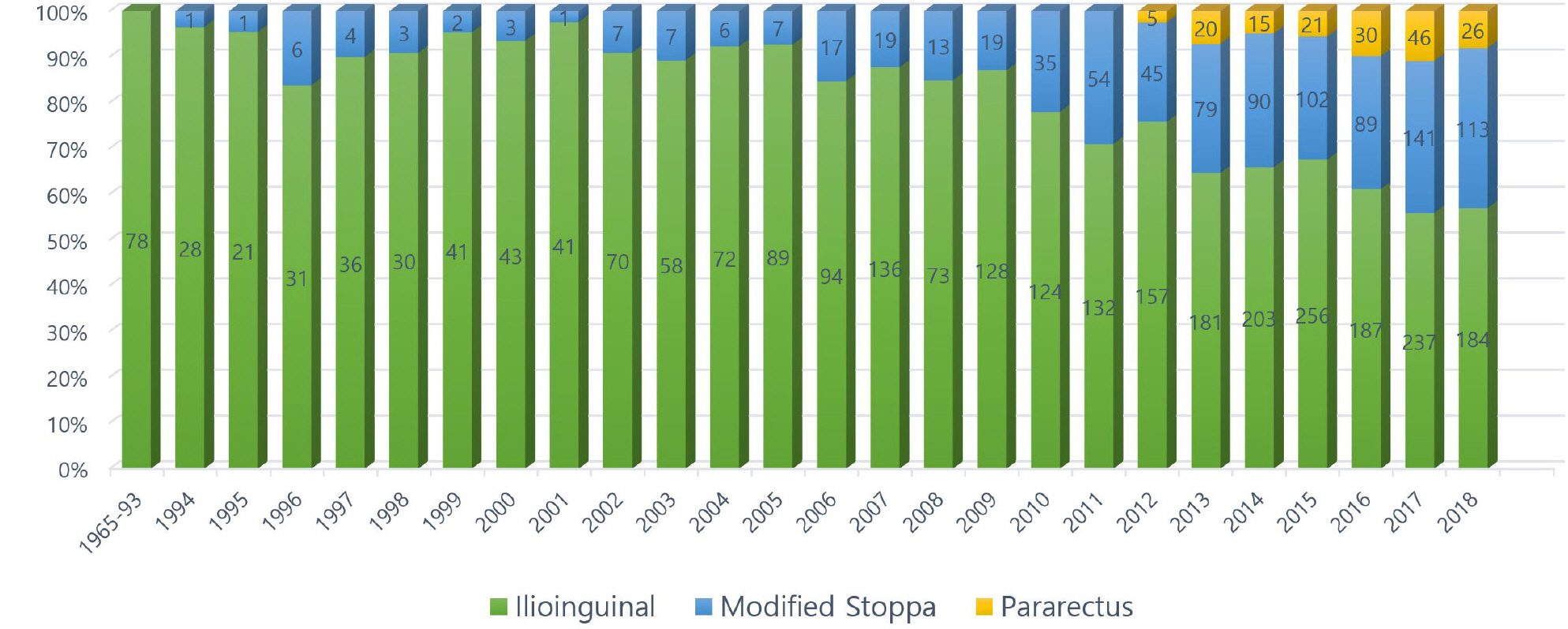J Korean Fract Soc.
2019 Jul;32(3):157-164. 10.12671/jkfs.2019.32.3.157.
Anterior Approach for the Acetabular Fractures
- Affiliations
-
- 1Department of Orthopaedic Surgery, Asan Medical Center, University of Ulsan College of Medicine, Seoul, Korea. bakpaker@hanmail.net
- 2Department of Orthopaedic Surgery, Korea University Guro Hospital, Korea University College of Medicine, Seoul, Korea.
- KMID: 2453069
- DOI: http://doi.org/10.12671/jkfs.2019.32.3.157
Abstract
- In the surgical treatment of acetabular fractures, the anterior approach is used widely for anterior column fractures with or without posterior column fractures. This paper reviews the anterior approach for the anatomical reduction and rigid fixation of acetabular fractures: traditional ilioinguinal approach, modified Stoppa approach, and new Pararectal approach.
Keyword
MeSH Terms
Figure
Reference
-
References
1. Letournel E. The treatment of acetabular fractures through the ilioinguinal approach. Clin Orthop Relat Res. 292:62–76. 1993.
Article2. Cole JD, Bolhofner BR. Acetabular fracture fixation via a modified Stoppa limited intrapelvic approach. Description of operative technique and preliminary treatment results. Clin Orthop Relat Res. 305:112–123. 1994.
Article3. Andersen RC, O'Toole RV, Nascone JW, Sciadini MF, Frisch HM, Turen CW. Modified stoppa approach for acetabular fractures with anterior and posterior column displacement: quantification of radiographic reduction and analysis of interobserver variability. J Orthop Trauma. 24:271–278. 2010.
Article4. Archdeacon MT, Kazemi N, Guy P, Sagi HC. The modified Stoppa approach for acetabular fracture. J Am Acad Orthop Surg. 19:170–175. 2011.
Article5. Hirvensalo E, Lindahl J, Kiljunen V. Modified and new approaches for pelvic and acetabular surgery. Injury. 38:431–441. 2007.
Article6. Kim JW, Kim YC. Modified Stoppa approach in acetabular fractures. J Korean Fract Soc. 27:274–280. 2014.
Article7. Keel MJ, Ecker TM, Cullmann JL, et al. The Pararectus approach for anterior intrapelvic management of acetabular fractures: an anatomical study and clinical evaluation. J Bone Joint Surg Br. 94:405–411. 2012.8. Tosounidis TH, Giannoudis VP, Kanakaris NK, Giannoudis PV. The Ilioinguinal approach: state of the art. JBJS Essent Surg Tech. 8:e19. 2018.9. Elmadağ M, Güzel Y, Acar MA, Uzer G, Arazi M. The Stoppa approach versus the ilioinguinal approach for anterior acetabular fractures: a case control study assessing blood loss complications and function outcomes. Orthop Traumatol Surg Res. 100:675–680. 2014.
Article10. Ruchholtz S, Buecking B, Delschen A, et al. The two-incision, minimally invasive approach in the treatment of acetabular fractures. J Orthop Trauma. 27:248–255. 2013.
Article11. Jimenez ML, Tile M, Schenk RS. Total hip replacement after acetabular fracture. Orthop Clin North Am. 28:435–446. 1997.
Article12. Matta JM. Operative treatment of acetabular fractures through the ilioinguinal approach: a 10-year perspective. J Orthop Trauma. 20:S20–S29. 2006.
Article13. Stoppa RE, Rives JL, Warlaumont CR, Palot JP, Verhaeghe PJ, Delattre JF. The use of Dacron in the repair of hernias of the groin. Surg Clin North Am. 64:269–285. 1984.
Article14. Kim JW, Seo YM, Jang HS. Reduction technique of dome impaction using the modified Stoppa approach – a technical note. J Korean Fract Soc. 30:131–136. 2017.15. Tannast M, Keel MJB, Siebenrock KA, Bastian JD. Open reduction and internal fixation of acetabular fractures using the modified Stoppa approach. JBJS Essent Surg Tech. 9:e3. 2019.
Article17. Keel MJ, Bastian JD, Büchler L, Siebenrock KA. [Anterior approaches to the acetabulum]. Unfallchirurg. 116:213–220. 2013; German.18. Kloen P, Siebenrock KA, Ganz R. Modification of the ilioinguinal approach. J Orthop Trauma. 16:586–593. 2002.
Article19. Laflamme GY, Hebert-Davies J, Rouleau D, Benoit B, Leduc S. Internal fixation of osteopenic acetabular fractures involving the quadrilateral plate. Injury. 42:1130–1134. 2011.
Article20. Keel MJB, Siebenrock KA, Tannast M, Bastian JD. The Pararectus approach: a new concept. JBJS Essent Surg Tech. 8:e21. 2018.21. Bastian JD, Savic M, Cullmann JL, Zech WD, Djonov V, Keel MJ. Surgical exposures and options for instrumentation in acetabular fracture fixation: Pararectus approach versus the modified Stoppa. Injury. 47:695–701. 2016.
Article22. Märdian S, Schaser KD, Hinz P, Wittenberg S, Haas NP, Schwabe P. Fixation of acetabular fractures via the ilioinguinal versus pararectus approach: a direct comparison. Bone Joint J. 97:1271–1278. 2015.23. Keel MJ, Tomagra S, Bonel HM, Siebenrock KA, Bastian JD. Clinical results of acetabular fracture management with the Pararectus approach. Injury. 45:1900–1907. 2014.
Article24. Bastian JD, Tannast M, Siebenrock KA, Keel MJ. Mid-term results in relation to age and analysis of predictive factors after fixation of acetabular fractures using the modified Stoppa approach. Injury. 44:1793–1798. 2013.
Article25. Isaacson MJ, Taylor BC, French BG, Poka A. Treatment of acetabulum fractures through the modified Stoppa approach: strategies and outcomes. Clin Orthop Relat Res. 472:3345–3352. 2014.
Article26. Ma K, Luan F, Wang X, et al. Randomized, controlled trial of the modified Stoppa versus the ilioinguinal approach for acetabular fractures. Orthopedics. 36:e1307–e1315. 2013.
Article27. Shazar N, Eshed I, Ackshota N, Hershkovich O, Khazanov A, Herman A. Comparison of acetabular fracture reduction quality by the ilioinguinal or the anterior intrapelvic (modified Rives-Stoppa) surgical approaches. J Orthop Trauma. 28:313–319. 2014.
Article28. Hammad AS, El-Khadrawe TA. Accuracy of reduction and early clinical outcome in acetabular fractures treated by the standard ilioinguinal versus the Stoppa/iliac approaches. Injury. 46:320–326. 2015.
Article
- Full Text Links
- Actions
-
Cited
- CITED
-
- Close
- Share
- Similar articles
-
- Combined Anterior and Posterior Approach in Operating on Complex Acetabular Fractures
- Modified Stoppa Approach in Acetabular Fractures
- Plain film analysis of acetabular fracture
- Treatment of Acetabular Column Fractures with Limited Open Reduction and Screw Fixation
- Anatomical Results According to Fracture Pattern after Surgical Treatment of Acetabular Fractures







